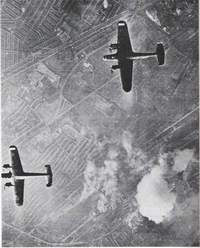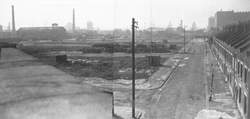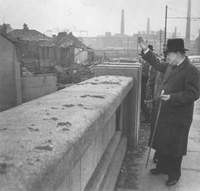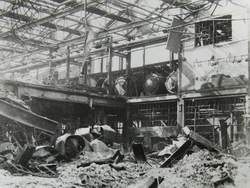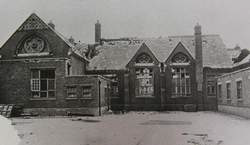Abandoned Communities ..... Central Silvertown
The period of most intensive bombing, known to those of a nostalgic bent as the Blitz, began on Saturday 7 September, 1940. From late afternoon until late into the night huge waves of German bombers, escorted by fighter aircraft, attacked East London. The docks, warehouses, and factories were their prime targets, but nearby residential areas also suffered major destruction. There were incendiary bombs, intended to start fires and after dark improve the visibility of targets for later waves of bombers, and there were high explosive bombs that caused damage by the blast they released.
Some people would have been able to take shelter at the first warning of the impending attack, though no form of shelter could guarantee safety if a direct hit occurred. The casualty figures for 7 September and later episodes of bombing must have included people from Silvertown. Others died two days later at a school in Canning Town. Agate Street School, one of the places where people were instructed to assemble, was located about half a mile north of the Royal Victoria dock. Hundreds of people, including many from Silvertown, gathered there that Saturday night. They were supposed to be collected by coach on Sunday to be removed to a safer place, but it seems that the coaches went to the wrong borough, possibly Camden Town instead of Canning Town. On Monday the coaches went to the right place, but as people were boarding them the sirens went off and the transfer was postponed again. That night the school suffered a direct hit, and a large number of people were killed.
An astonishingly detailed description of events during the first day and night of bombing can be read in the reminiscences of Cyril Demarne. Recorded in 1986, they were published in Winston G Ramsey (ed.), The East End Then And Now, Battle of Britain Prints International Ltd, 1997. Or go to the WW2 People’s War website for the sketchy but intermittently vivid memories of Keith Llewellyn. Keith, three years old at the time, lived in Kempton Street with his mother and Aunt Toots.
The bombing of east London continued until 10 May 1941. On that night, regarded as the worst night of the Blitz, nearly 1500 people were killed and about 1800 seriously injured.
Some people may have been able to move in with friends and relatives. Many, however, were left homeless. A limited amount of reconstruction began during the war, but a large number of people from east London stayed in temporary accommodation until after the war ended in 1945. Pre-fabricated housing, much of which remained in use several decades later, was then provided, and before long new housing estates gradually emerged. Some of the people from central Silvertown may have settled on the Keir Hardie estate in Canning Town.
Some people would have been able to take shelter at the first warning of the impending attack, though no form of shelter could guarantee safety if a direct hit occurred. The casualty figures for 7 September and later episodes of bombing must have included people from Silvertown. Others died two days later at a school in Canning Town. Agate Street School, one of the places where people were instructed to assemble, was located about half a mile north of the Royal Victoria dock. Hundreds of people, including many from Silvertown, gathered there that Saturday night. They were supposed to be collected by coach on Sunday to be removed to a safer place, but it seems that the coaches went to the wrong borough, possibly Camden Town instead of Canning Town. On Monday the coaches went to the right place, but as people were boarding them the sirens went off and the transfer was postponed again. That night the school suffered a direct hit, and a large number of people were killed.
An astonishingly detailed description of events during the first day and night of bombing can be read in the reminiscences of Cyril Demarne. Recorded in 1986, they were published in Winston G Ramsey (ed.), The East End Then And Now, Battle of Britain Prints International Ltd, 1997. Or go to the WW2 People’s War website for the sketchy but intermittently vivid memories of Keith Llewellyn. Keith, three years old at the time, lived in Kempton Street with his mother and Aunt Toots.
The bombing of east London continued until 10 May 1941. On that night, regarded as the worst night of the Blitz, nearly 1500 people were killed and about 1800 seriously injured.
Some people may have been able to move in with friends and relatives. Many, however, were left homeless. A limited amount of reconstruction began during the war, but a large number of people from east London stayed in temporary accommodation until after the war ended in 1945. Pre-
Four
German bombers on 7 September 1940. Central Silvertown lies underneath the cloud of smoke in the bottom right.
Oriental Road and the streets to the south of it after May 1941
An emotional Winston Churchill on Silvertown Viaduct
Agate Street School
Silvertown Rubber Factory
